Mold release film and process for producing semiconductor package
a technology of mold release film and semiconductor package, which is applied in the direction of packaging foodstuffs, packaged goods types, synthetic resin layered products, etc., can solve the problems of poor appearance, easy formation of wrinkles in the mold release film, and hardly releasable proportions, so as to improve the productivity of the semiconductor package, improve the followability to the mold, and improve the effect of the semiconductor packag
- Summary
- Abstract
- Description
- Claims
- Application Information
AI Technical Summary
Benefits of technology
Problems solved by technology
Method used
Image
Examples
first embodiment
[0248]As one embodiment of the process for producing a semiconductor package, a case of producing a semiconductor package 1 as shown in FIG. 1 by the process (α), will be described in detail.
Mold:
[0249]As the mold in the first embodiment, it is possible to use one known as a mold to be used for compression molding, and for example, as shown in FIG. 2, a mold comprising a stationary upper mold 20, a cavity bottom member 22, and a frame-shaped movable lower mold 24 disposed at the periphery of the cavity bottom member 22, may be mentioned.
[0250]In the stationary upper mold 20, a vacuum vent (not shown) for adsorbing a substrate 10 to the stationary upper mold 20 by sucking air between the substrate 10 and the stationary upper mold 20, is formed. Further, in the cavity bottom member 22, a vacuum vent (not shown) for adsorbing a mold release film 30 to the cavity bottom member 22 by sucking air between the mold release film 30 and the cavity bottom member 22, is formed.
[0251]In this mol...
second embodiment
[0289]Another embodiment of the process for producing a semiconductor package will be described in detail with reference to a case of producing a semiconductor package 1 shown in FIG. 1 by the process (β).
Mold:
[0290]As the mold in the second embodiment, it is possible to use one known as a mold to be used for a transfer molding method. For example, as shown in FIG. 5, a mold comprising an upper mold 50 and a lower mold 52, may be mentioned. In the upper mold 50, a cavity 54 having a shape corresponding to the shape of the resin-encapsulation portion 14 to be formed in the step (β4), and a concave-shaped resin-introducing portion 60 to introduce a curable resin 40 to the cavity 54 are formed. In the lower mold 52, a substrate placement portion 58 for placing a substrate 10 having semiconductor chips 12 mounted thereon, and a resin placement portion 62 for placing a curable resin 40 are formed. Further, in the resin placement portion 62, a plunger 64 is provided that pushes the curabl...
production example 1
Production of ETFE (1)
[0321]A polymerization tank having an internal capacity of 1.3 L and equipped with a stirrer, was deaerated; 881.9 g of 1-hydrotridecafluoro-hexane, 335.5 g of 1,3-dichloro-1,1,2,2,3-pentafluoropropane (trade name “AK225cb” manufactured by Asahi Glass Company, Ltd., hereinafter referred to as AK225cb) and 7.0 g of CH2═CHCF2CF2CF2CF3 (PFBE), were charged; 165.2 g of TFE and 9.8 g of ethylene (hereinafter referred to as E) were injected; the temperature in the polymerization tank was raised to 66° C.; and as a polymerization initiator solution, 7.7 mL of an AK225cb solution containing 1 mass % of tert-butyl peroxypivalate (hereinafter referred to as PBPV) was charged to initiate the polymerization.
[0322]A monomer mixture gas of TFE / E=54 / 46 by molar ratio was continuously charged so that the pressure would be constant during the polymerization. Further, along with the charging of the monomer mixture gas, PFBE was continuously charged in an amo...
PUM
| Property | Measurement | Unit |
|---|---|---|
| Ra | aaaaa | aaaaa |
| thickness | aaaaa | aaaaa |
| thickness | aaaaa | aaaaa |
Abstract
Description
Claims
Application Information
 Login to View More
Login to View More - R&D
- Intellectual Property
- Life Sciences
- Materials
- Tech Scout
- Unparalleled Data Quality
- Higher Quality Content
- 60% Fewer Hallucinations
Browse by: Latest US Patents, China's latest patents, Technical Efficacy Thesaurus, Application Domain, Technology Topic, Popular Technical Reports.
© 2025 PatSnap. All rights reserved.Legal|Privacy policy|Modern Slavery Act Transparency Statement|Sitemap|About US| Contact US: help@patsnap.com



